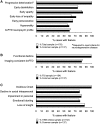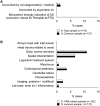Sensitivity of revised diagnostic criteria for the behavioural variant of frontotemporal dementia
- PMID: 21810890
- PMCID: PMC3170532
- DOI: 10.1093/brain/awr179
Sensitivity of revised diagnostic criteria for the behavioural variant of frontotemporal dementia
Abstract
Based on the recent literature and collective experience, an international consortium developed revised guidelines for the diagnosis of behavioural variant frontotemporal dementia. The validation process retrospectively reviewed clinical records and compared the sensitivity of proposed and earlier criteria in a multi-site sample of patients with pathologically verified frontotemporal lobar degeneration. According to the revised criteria, 'possible' behavioural variant frontotemporal dementia requires three of six clinically discriminating features (disinhibition, apathy/inertia, loss of sympathy/empathy, perseverative/compulsive behaviours, hyperorality and dysexecutive neuropsychological profile). 'Probable' behavioural variant frontotemporal dementia adds functional disability and characteristic neuroimaging, while behavioural variant frontotemporal dementia 'with definite frontotemporal lobar degeneration' requires histopathological confirmation or a pathogenic mutation. Sixteen brain banks contributed cases meeting histopathological criteria for frontotemporal lobar degeneration and a clinical diagnosis of behavioural variant frontotemporal dementia, Alzheimer's disease, dementia with Lewy bodies or vascular dementia at presentation. Cases with predominant primary progressive aphasia or extra-pyramidal syndromes were excluded. In these autopsy-confirmed cases, an experienced neurologist or psychiatrist ascertained clinical features necessary for making a diagnosis according to previous and proposed criteria at presentation. Of 137 cases where features were available for both proposed and previously established criteria, 118 (86%) met 'possible' criteria, and 104 (76%) met criteria for 'probable' behavioural variant frontotemporal dementia. In contrast, 72 cases (53%) met previously established criteria for the syndrome (P < 0.001 for comparison with 'possible' and 'probable' criteria). Patients who failed to meet revised criteria were significantly older and most had atypical presentations with marked memory impairment. In conclusion, the revised criteria for behavioural variant frontotemporal dementia improve diagnostic accuracy compared with previously established criteria in a sample with known frontotemporal lobar degeneration. Greater sensitivity of the proposed criteria may reflect the optimized diagnostic features, less restrictive exclusion features and a flexible structure that accommodates different initial clinical presentations. Future studies will be needed to establish the reliability and specificity of these revised diagnostic guidelines.
Figures





Comment in
-
Sense and sensitivity of novel criteria for frontotemporal dementia.Brain. 2011 Sep;134(Pt 9):2450-3. doi: 10.1093/brain/awr208. Epub 2011 Aug 22. Brain. 2011. PMID: 21859764 No abstract available.
-
Considering the frontomedian cortex in revised criteria for behavioural variant frontotemporal dementia.Brain. 2012 Apr;135(Pt 4):e213; author reply e214. doi: 10.1093/brain/aws030. Epub 2012 Feb 23. Brain. 2012. PMID: 22362608 Free PMC article. No abstract available.
Similar articles
-
The behavioural/dysexecutive variant of Alzheimer's disease: clinical, neuroimaging and pathological features.Brain. 2015 Sep;138(Pt 9):2732-49. doi: 10.1093/brain/awv191. Epub 2015 Jul 2. Brain. 2015. PMID: 26141491 Free PMC article.
-
Proposed research criteria for prodromal behavioural variant frontotemporal dementia.Brain. 2022 Apr 29;145(3):1079-1097. doi: 10.1093/brain/awab365. Brain. 2022. PMID: 35349636 Free PMC article.
-
Diagnostic accuracy of behavioral variant frontotemporal dementia consortium criteria (FTDC) in a clinicopathological cohort.Neuropathol Appl Neurobiol. 2015 Dec;41(7):882-92. doi: 10.1111/nan.12194. Epub 2015 May 2. Neuropathol Appl Neurobiol. 2015. PMID: 25381753
-
The behavioral variant of frontotemporal dementia: linking neuropathology to social cognition.Neurol Sci. 2013 Aug;34(8):1267-74. doi: 10.1007/s10072-013-1317-9. Epub 2013 Feb 3. Neurol Sci. 2013. PMID: 23377232 Review.
-
Behavioural variant frontotemporal dementia--defining genetic and pathological subtypes.J Mol Neurosci. 2011 Nov;45(3):583-8. doi: 10.1007/s12031-011-9542-2. Epub 2011 May 11. J Mol Neurosci. 2011. PMID: 21559874 Review.
Cited by
-
Elevated peripheral inflammation is associated with choroid plexus enlargement in independent sporadic amyotrophic lateral sclerosis cohorts.Fluids Barriers CNS. 2024 Oct 21;21(1):83. doi: 10.1186/s12987-024-00586-w. Fluids Barriers CNS. 2024. PMID: 39434103 Free PMC article.
-
Caring for loved ones with frontotemporal degeneration: the lived experiences of spouses.Geriatr Nurs. 2013 Jul-Aug;34(4):302-6. doi: 10.1016/j.gerinurse.2013.05.001. Epub 2013 May 30. Geriatr Nurs. 2013. PMID: 23726759 Free PMC article.
-
Emotion recognition in frontotemporal dementia and Alzheimer's disease: A new film-based assessment.Emotion. 2015 Aug;15(4):416-27. doi: 10.1037/a0039261. Epub 2015 May 25. Emotion. 2015. PMID: 26010574 Free PMC article.
-
Regional cerebral blood flow single photon emission computed tomography for detection of Frontotemporal dementia in people with suspected dementia.Cochrane Database Syst Rev. 2015 Jun 23;2015(6):CD010896. doi: 10.1002/14651858.CD010896.pub2. Cochrane Database Syst Rev. 2015. PMID: 26102272 Free PMC article. Review.
-
Grey and white matter changes across the amyotrophic lateral sclerosis-frontotemporal dementia continuum.PLoS One. 2012;7(8):e43993. doi: 10.1371/journal.pone.0043993. Epub 2012 Aug 29. PLoS One. 2012. PMID: 22952843 Free PMC article.
References
-
- Ames D, Cummings JL, Wirshing WC, Quinn B, Mahler M. Repetitive and compulsive behavior in frontal lobe degenerations. J Neuropsychiatry Clin Neurosci. 1994;6:100–13. - PubMed
-
- Baborie A, Griffiths TD, Jaros E, McKeith IG, Burn DJ, Richardson A, et al. Pathological correlates of frontotemporal lobar degeneration in the elderly. Acta Neuropathol. 2010;121:365–71. - PubMed
-
- Baker M, Mackenzie IR, Pickering-Brown SM, Gass J, Rademakers R, Lindholm C, et al. Mutations in progranulin cause tau-negative frontotemporal dementia linked to chromosome 17. Nature. 2006;442:916–9. - PubMed
-
- Bathgate D, Snowden JS, Varma A, Blackshaw A, Neary D. Behaviour in frontotemporal dementia, Alzheimer's disease and vascular dementia. Acta Neurol Scand. 2001;103:367–78. - PubMed
Publication types
MeSH terms
Grants and funding
- P50 AG023501/AG/NIA NIH HHS/United States
- P01-AG17586/AG/NIA NIH HHS/United States
- G0601846/MRC_/Medical Research Council/United Kingdom
- P50-AG023501/AG/NIA NIH HHS/United States
- R01 AG032306/AG/NIA NIH HHS/United States
- P01-AG019724/AG/NIA NIH HHS/United States
- R01-AG034499-02/AG/NIA NIH HHS/United States
- R01-NS44266/NS/NINDS NIH HHS/United States
- G9724461/MRC_/Medical Research Council/United Kingdom
- R01 NS044266/NS/NINDS NIH HHS/United States
- P01 AG032953/AG/NIA NIH HHS/United States
- R01 AG015116/AG/NIA NIH HHS/United States
- 13129/Canadian Institutes of Health Research/Canada
- R01-AG15116/AG/NIA NIH HHS/United States
- P01 AG017586/AG/NIA NIH HHS/United States
- R01 AG034499/AG/NIA NIH HHS/United States
- UL1 RR025741/RR/NCRR NIH HHS/United States
- P01 AG019724/AG/NIA NIH HHS/United States
- P50-AG016574/AG/NIA NIH HHS/United States
- P01-AG32953/AG/NIA NIH HHS/United States
- G0801306/MRC_/Medical Research Council/United Kingdom
- 091673/Wellcome Trust/United Kingdom
LinkOut - more resources
Full Text Sources
Other Literature Sources
Miscellaneous

